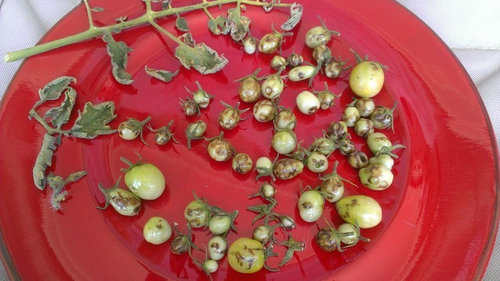What is ruining my Supersweet 100 fruit?
amunk01
10 years ago
Related Stories

SUMMER FRUITS AND VEGETABLESHow to Grow Your Own Fresh, Sweet Corn
Here's how to plant and care for your own mini cornfield
Full Story
EDIBLE GARDENSSummer Crops: How to Grow Tomatoes
Plant tomato seedlings in spring for one of the best tastes of summer, fresh from your backyard
Full Story
HEALTHY HOME12 Ways to Set Up Your Kitchen for Healthy Eating
Making smart food choices is easier when your kitchen is part of your support team
Full Story
MOST POPULARThe Easiest, Most Versatile Cake Stand You'll Ever Make
Show off sweet somethings and your own impressive handiwork — just don't let on how little effort it took
Full Story
GARDENING GUIDESPlant Black Cherry Trees for the Birds and Bees
Plant Prunus serotina in the Central and Eastern U.S. for spring flowers, interesting bark and beautiful fall color
Full Story
FARMHOUSESWorld of Design: See How 9 Families Live and Farm on Their Land
Join us as we visit the homes and farms of passionate food producers and hear about rural life around the globe
Full Story
GARDENING AND LANDSCAPINGBid Bad Garden Bugs Goodbye and Usher In the Good
Give ants their marching orders and send mosquitoes moseying, while creating a garden that draws pollinators and helpful eaters
Full Story
FARM YOUR YARDHow to Farm Your Parking Strip
Get an up-close look at a thriving street-side edible garden, one of many sprouting up in Seattle
Full Story
GARDENING GUIDESGarden Myths to Debunk as You Dig This Fall and Rest Over Winter
Termites hate wood mulch, don’t amend soil for trees, avoid gravel in planters — and more nuggets of garden wisdom
Full Story
FARM YOUR YARDRemake Your Backyard Into a Mini Farm
You can get a taste of country life by line-drying your laundry, growing some produce or going whole hog with the critters
Full StorySponsored
More Discussions







Okiedawn OK Zone 7
amunk01Original Author
Related Professionals
Foothill Ranch Landscape Architects & Landscape Designers · Roxbury Crossing Landscape Architects & Landscape Designers · Mooresville Landscape Contractors · Andover Landscape Contractors · Braintree Landscape Contractors · Centennial Decks, Patios & Outdoor Enclosures · Columbia Decks, Patios & Outdoor Enclosures · Fort Lee Decks, Patios & Outdoor Enclosures · Littleton Decks, Patios & Outdoor Enclosures · Livingston Decks, Patios & Outdoor Enclosures · Montgomery County Decks, Patios & Outdoor Enclosures · Parlier Decks, Patios & Outdoor Enclosures · Schaumburg Decks, Patios & Outdoor Enclosures · Wilmington Decks, Patios & Outdoor Enclosures · Highland Decks, Patios & Outdoor Enclosuresamunk01Original Author
Okiedawn OK Zone 7
elkwc
amunk01Original Author
oldbusy1
Okiedawn OK Zone 7
oldbusy1
oldbusy1
Okiedawn OK Zone 7
amunk01Original Author
Okiedawn OK Zone 7
elkwc
amunk01Original Author
Okiedawn OK Zone 7
amunk01Original Author
Okiedawn OK Zone 7
elkwc
Okiedawn OK Zone 7